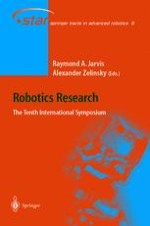At the dawn of the new millennium, robotics is undergoing a major transfor- tion in scope and dimension. From a largely dominant industrial focus, robotics is rapidly expanding into the challenges of unstructured environments. Inter- ting with, assisting, serving, and exploring with humans, the emerging robots will increasingly touch people and their lives. The goal of this new series of Springer Tracts in Advanced Robotics is to bring,inatimelyfashion,thelatestadvancesanddevelopmentsinroboticsonthe basisoftheirsigni?canceandquality.Itisourhopethatthegreaterdissemination of research developments will stimulate more exchanges and collaborations among the research community and contribute to further advancement of this rapidly growing ?eld. As one of robotics pioneering symposia, ISRR, the "International Sym- sium on Robotics Research," has established over the past two decades some of the ?eld’s most fundamental and lasting contributions.With the launching of STAR, this and other thematic symposia devoted to excellence in robotics ?nd an important platform for closer links and extended reach within the research community. The Tenth edition of "Robotics Research" edited by Raymond Jarvis and AlexZelinskyoffersinits11-partvolumeacollectionofabroadrangeoftopics in robotics. The content of these contributions provides a wide coverage of the current state of robotics research: the advances and challenges in its theoretical foundation and technology basis, and the developments in its traditional and new areas of applications.
